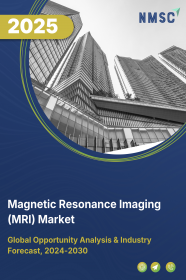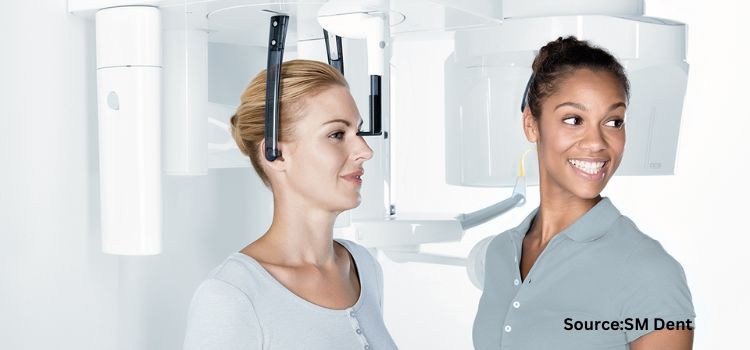
Magnetic Resonance Imaging (MRI) Market by Product Type (Open MRI and Close MRI), by Field Strength(High Field System, Medium Field System and Low Field System), by Application (Brain and Neurological, Spine and Musculoskeletal, Vascular, Abdominal, Cardiac, Breast, and Others), and by Enduser (Hospitals, Imaging Centers, Ambulatory Surgical Centers, and Others) - Global Opportunity Analysis and Industry Forecast, 2025 – 2030
Industry: Healthcare | Publish Date: 11-Mar-2025 | No of Pages: 449 | No. of Tables: 303 | No. of Figures: 245 | Format: PDF | Report Code : HC398
US Tariff Impact on Magnetic Resonance Imaging (MRI) Market
Trump Tariffs Are Reshaping Global Business
Market Definition
The Magnetic Resonance Imaging (MRI) Market was valued at USD 10.78 billion in 2024 and is predicted to reach USD 21.97 billion by 2030 with a CAGR of 6.20% from 2025-2030.
Magnetic resonance imaging is a diagnostic technology that uses a strong magnetic field and radio waves to produce detailed pictures of the internal organs. MRI can provide anatomical images of the brain or spinal cord using different sequences of magnetic pulses.
MRI pictures also help to detect brain injuries, brain damages associated with epilepsy, abnormally developed brain regions, neurodegenerative disorders, tumors, inflammation, infection, vascular irregularities and strokes. It also provides accurate information about the structure of the bones, soft tissues and joints. MRI technology does not use ionizing radiation and thereby less harmful than X-rays and CT scans.
Market Dynamics and Trends
The rising public awareness and improving healthcare facilities have increased the demand for better diagnosis and treatment, which in turn has been driving the magnetic resonance imaging market growth. Also, the rise in various cardiovascular, neurological, and ophthalmic diseases along with growing geriatric population are factors expected to increase the demand for MRI scans for accurate diagnosis, thus driving the MRI market growth during the forecast period.
Moreover, rise in trauma cases, constant innovation in the MRI machines by the market players, increased demand for accurate diagnosis and the potential to provide in-depth photographs of soft tissues and vascular systems are factors expected to boost the MRI market growth.
However, reduced reimbursement amounts, lack of expert professionals and high cost associated with the installation of MRI systems are few factors expected to restrain the market growth to some extent. On the other hand, increasing investments in R&D activities and development of cost-effective MRI machines are expected to provide ample growth opportunities for the market players in the coming years.
Market Segmentations and Scope of the Study
The magnetic resonance imaging market is categorized on the basis of product type, field strength, application, enduser and geography. On the basis of product type, the market is segmented into, open MRI and close MRI. On the basis of field strength, the market is divided into high field system, medium field system and low field system. Based on application, the market is categorized into brain and neurological, spine and musculoskeletal, vascular, abdominal, cardiac, breast, and others. Based on enduser, the market is bifurcated into hospitals, imaging centers, ambulatory surgical centers, and others. Geographic breakdown and analysis of each of the aforesaid segments include regions comprising North America, Europe, Asia-Pacific, and RoW.
Geographical Analysis
North America holds the lion share of the MRI market at present. This is attributed to factors such as higher healthcare expenditure, rising cases of chronic diseases, and introduction of hybrid MRI systems in this region. Europe is holding the second-largest share of the market due to growing demand of advanced diagnostic devices and increasing geriatric population.
However, Asia Pacific is expected to show fastest growth in terms of market share owing to rapid expansion of healthcare industry, increasing awareness about the benefits of early diagnosis and availability of low-cost healthcare services.
Competitive Landscape
The key players of magnetic resonance imaging market include GE Healthcare, Siemens Healthcare, Philips Healthcare, Hitachi Medical Corporation, Toshiba Medical Systems Corporation, Shimadzu Corp, Carestream Health, Hologic, Barco and Nordion Inc. The market players of MRI have been making new strategic collaborations and launching innovative products in order to maintain their dominance over the market.
For instance, in December 21, 2020, GE Healthcare signed an agreement with Profound Medical to expand Profound’s potential TULSA-PRO system by interfacing it with GE’s new MRI scanners. Also, in July 17, 2020, Philips Healthcare had launched helium free MRI machine that consists of revolutionary Blue Seal magnet and operates with only seven liters of helium, instead of usual 1500 liters.
Key Benefits
-
The magnetic resonance imaging market report provides the quantitative analysis of the current market and estimations through 2022-2030 that assists in identifying the prevailing market opportunities to capitalize on. The study comprises a deep dive analysis of the magnetic resonance imaging market trend including the current and future trends for depicting the prevalent investment pockets in the market.
-
The information related to key drivers, restraints and opportunities and their impact on the magnetic resonance imaging market is provided in the report.
-
The competitive analysis of the market players along with their market share in the global magnetic resonance market.
-
The SWOT analysis and Porters Five Forces model is elaborated in the study.
-
Value chain analysis in the market study provides a clear picture of the stakeholders’ roles.
Key Market Segments
By Product Type
-
Open MRI
-
Close MRI
By Field Strength
-
High field
-
Mid field
-
Low field
By Application
-
Brain and Neurological
-
Spine and Musculoskeletal
-
Vascular
-
Abdominal
-
Cardiac
-
Breast
-
Others
By Enduser
-
Hospitals
-
Imaging Centers
-
Ambulatory Surgical Centers
-
Others
By Geography
-
North America
-
The U.S.
-
Canada
-
Mexico
-
-
Europe
-
The UK
-
Germany
-
France
-
Italy
-
Spain
-
Denmark
-
Netherlands
-
Finland
-
Sweden
-
Norway
-
Russia
-
Rest of Europe
-
-
Asia-Pacific
-
China
-
Japan
-
India
-
South Korea
-
Australia
-
Indonesia
-
Singapore
-
Taiwan
-
Thailand
-
Rest of Asia-Pacific
-
-
RoW
-
Latin America
-
Middle East
-
Africa
-
Key Players
-
Canon Medical Systems Corporation
-
Siemens Healthineers AG
-
Aspect Imaging
-
Bruker
-
Neusoft Medical System
-
Shenzhen Basda Medical Apparatus Co. Ltd
-
General Electric
-
Koninklijke Philips N.V.
-
Carestream Health
-
Time Medical Systems
-
Shenzhen Anke Hi-Tech Co. Ltd
-
Shanghai United Imaging Healthcare Co. Ltd.
-
Esaote Spa
-
Fujifilm Holdings Corporation
-
Fonar Corporation
REPORT SCOPE AND SEGMENTATION:
|
Parameters |
Details |
|
Analysis Period |
2024–2030 |
|
Base Year Considered |
2024 |
|
Forecast Period |
2025–2030 |
|
Market Size Estimation |
Billion (USD) |
|
Market Segmentation |
By Product Type (Open MRI and Close MRI), by Field Strength (High Field System, Medium Field System and Low Field System), by Application (Brain and Neurological, Spine and Musculoskeletal, Vascular, Abdominal, Cardiac, Breast, and Others), and by Enduser (Hospitals, Imaging Centers, Ambulatory Surgical Centers, and Others) |
|
Geographical Segmentation |
North America (U.S., Canada, Mexico) Europe (UK, Germany, France, Rest of Europe), Asia-Pacific (China, Japan, India, Rest of APAC), Rest of the World (Brazil, Mexico, Remaining Countries) |
|
Companies Profiled |
GE Healthcare, Siemens Healthcare, Philips Healthcare, Hitachi Medical Corporation, Toshiba Medical Systems Corporation, Shimadzu Corp, Carestream Health, Hologic, Barco and Nordion Inc. |

















 Speak to Our Analyst
Speak to Our Analyst





















